Caffeinated drinks are a part of most people’s daily routines. But we don't often consider the caffeine content in chocolate when reaching for something to wake us right up. This is because caffeine is so closely associated with coffee, and a widely consumed stimulant.
It awakens body & mind when it interacts with both the serotonin and adenosine receptors in our brains. Yet the caffeine levels in chocolate can be comparable to a shot of espresso or 8oz of strong black tea, and the effects are further compounded by its cousin chemical theobromine.
But when it comes the level of caffeine in chocolate, coffee, and tea, each source varies greatly, as there are factors in each one that affect the amount in the final product. While generally speaking, chocolate contains significantly less caffeine than coffee or tea, there are certain cases where this isn’t true. Read on to find out when.
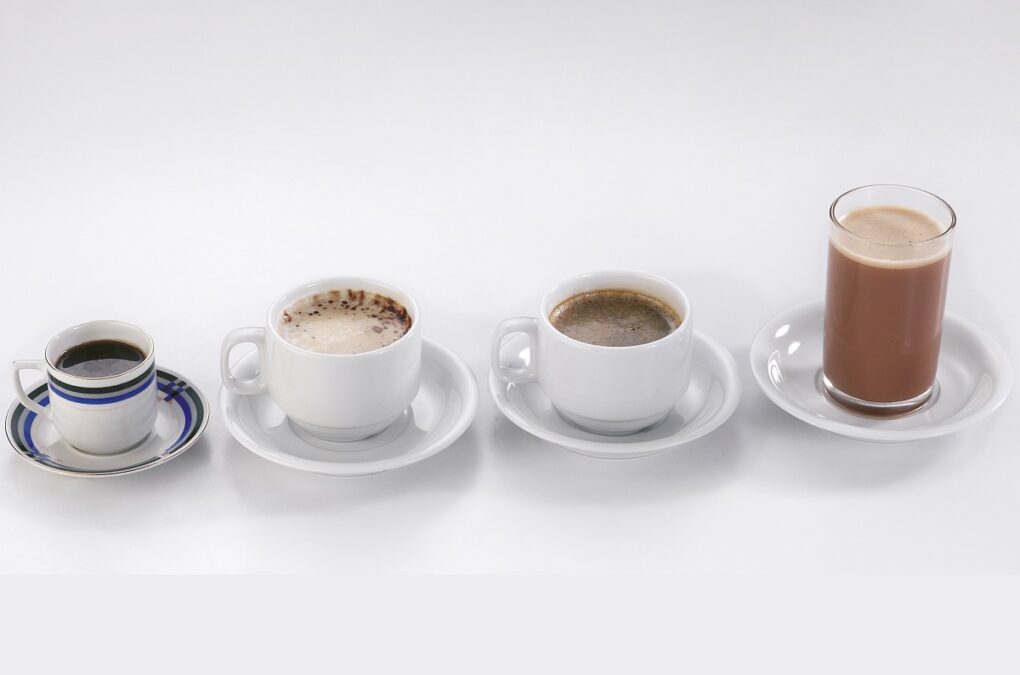
Jump To
How Much Caffeine in Chocolate?
Caffeine is part of the methylxanthine family of substances, and when taken in small, regular doses it can provide beneficial bursts of energy, depending on your body's sensitivity to it. Information on the amount of caffeine in chocolate can be varied and sometimes contradictory.
However in most cases, there’s less caffeine in chocolate compared to coffee and tea. This is because caffeine is only found in the cocoa solids of the cacao bean and not in the cocoa butter.
Since white chocolate is mostly cocoa butter and doesn’t have any cocoa solids, it won’t contain any caffeine. Beyond that, more cocoa solids generally means higher caffeine content.
For a general rule of thumb, the following estimates can also be considered to determine the caffeine content in chocolate; 12 mg per ounce dark chocolate, 5.8 mg per ounce milk chocolate, and 0 mg caffeine in white chocolate.
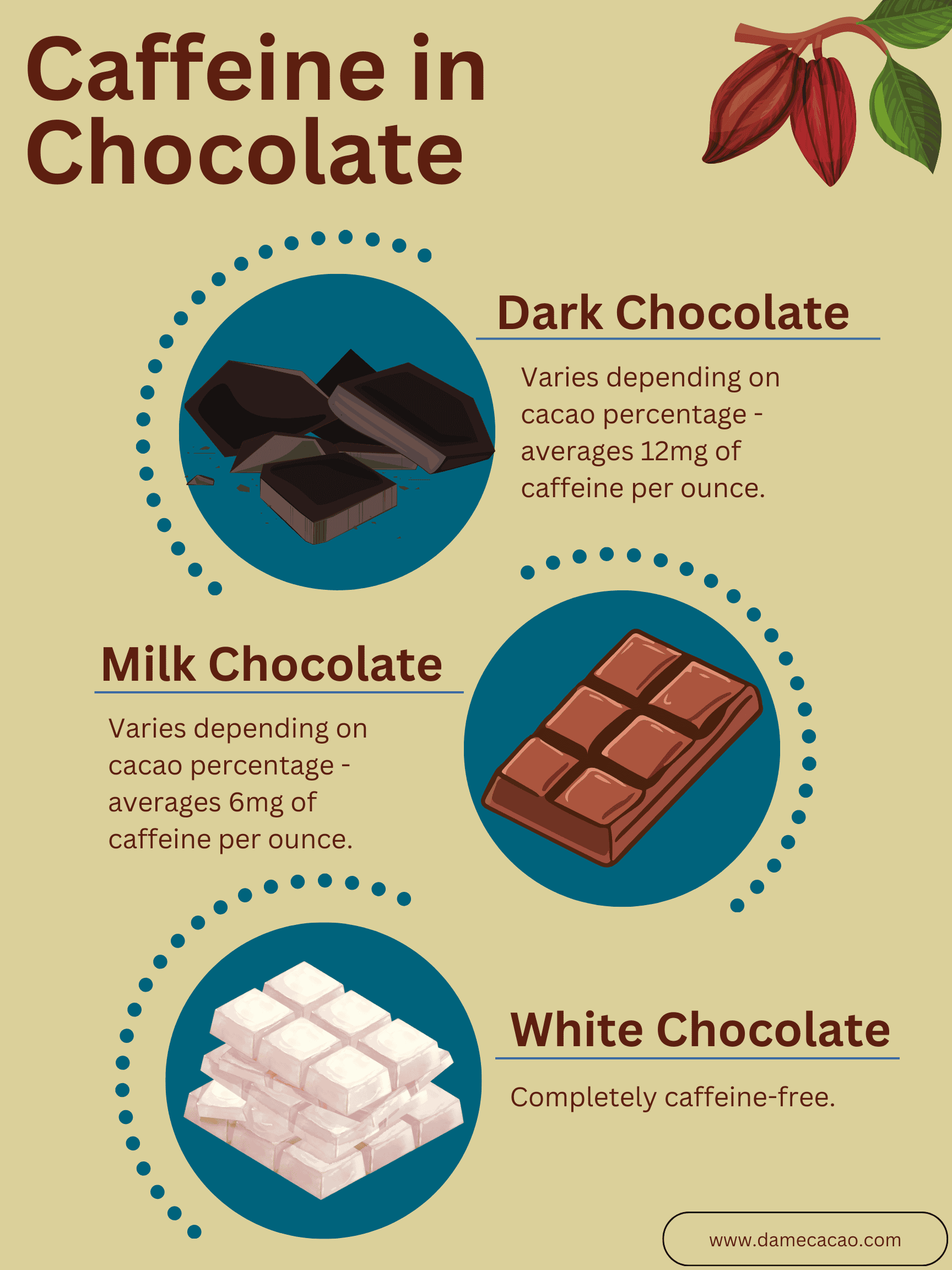
Some of you may also be wondering about cacao-containing products, like cocoa nibs or java chips. Both of those have some amount of caffeine and theobromine, but the java chips will contain less than the nibs due to their low cacao content.
When including chocolates that use the more caffeine-rich South American cocoa beans in their production, the average shoots up to about 54 mg caffeine per 50-gram bar of 75% dark chocolate and 7 mg for milk chocolate.
This is the perfect illustration of how the origin of cocoa beans used to make the chocolate also contribute to chocolate’s caffeine content. Cocoa beans from Ecuador, Venezuela, and Peru will contain as much as 2 times the caffeine of their West African counterparts.
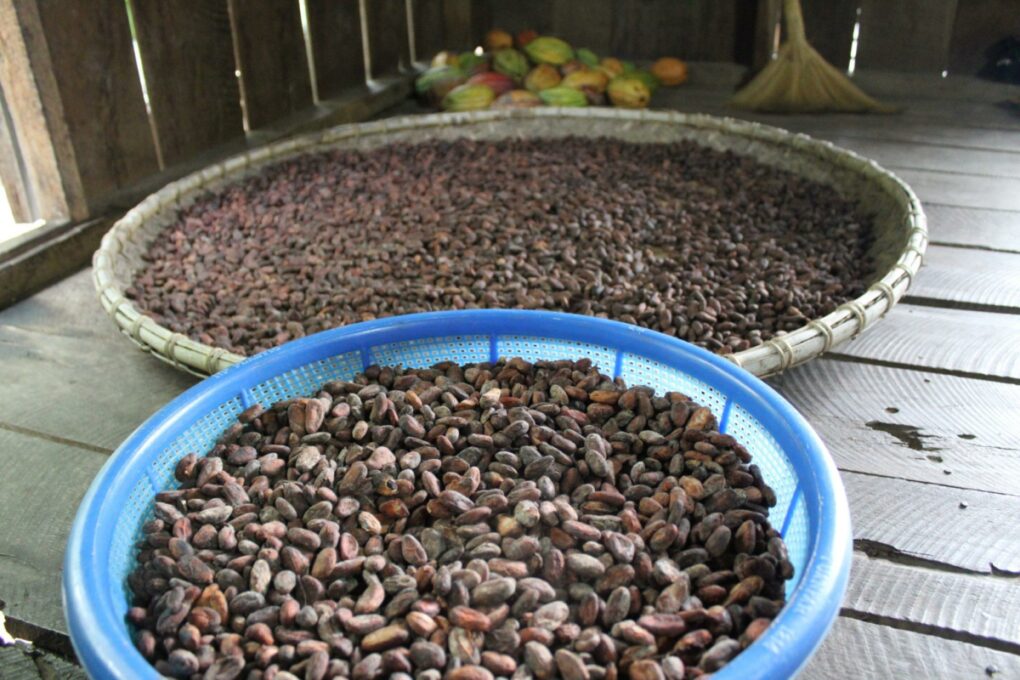
Theobromine in Chocolate
In addition to caffeine, chocolate contains an alkaloid in the same family called theobromine. It’s an unusual chemical in that it’s found in cocoa beans as well as the breakdown of caffeine itself. Theobromine can be thought of as a stimulant, with similar energy-boosting effects as caffeine, though to a much lesser degree.
It opens blood vessels to increase the flow of oxygen and nutrients to the brain, and also acts as a diuretic that promotes filtering in the kidneys. This helps urine production that rids the body of salt and water. Despite this diuretic function, the consumption of caffeinated drinks are overall more hydrating than the liquids the body expels.
Theobromine binds to the body’s central nervous system in the same way caffeine does. However, due to the weaker bond it forms, its effect is 10 times weaker but longer lasting than caffeine. On the other hand, it doesn’t cause an energy crash like caffeine is prone to.
Just like caffeine in chocolate, the consumption of theobromine can cause complications if you take too much (or are not used to it). Side effects of overconsumption can include nausea, vomiting, headaches, palpitations, anxiety, and restlessness. And as with caffeine, an extremely excessive intake can be lethal.
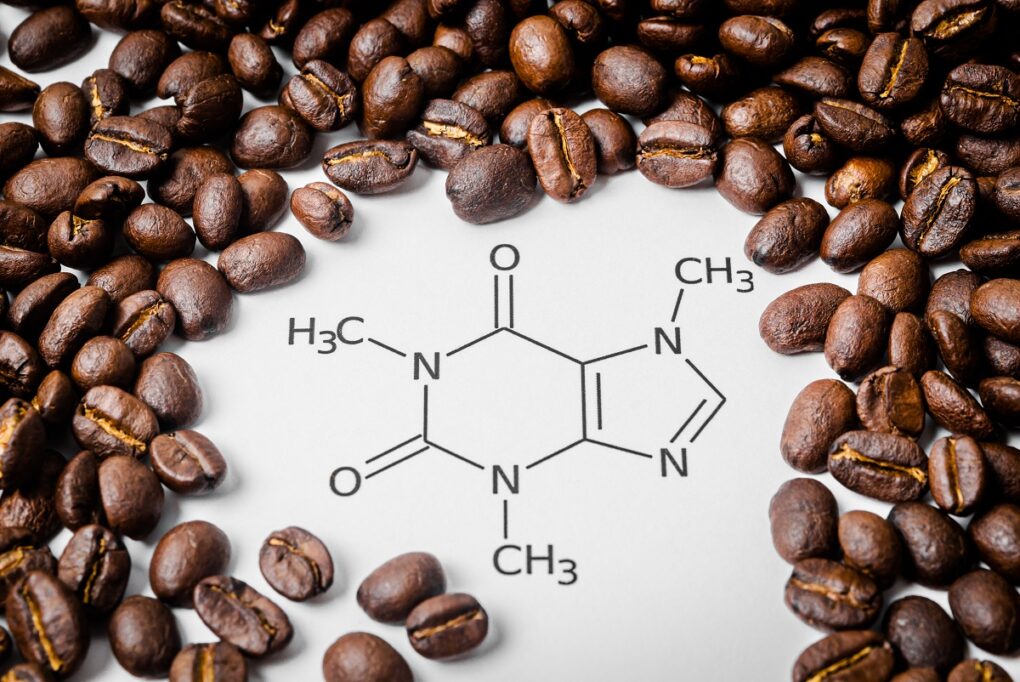
Caffeine in Chocolate vs. Coffee
Coffee is the most popular hot drink in the world that contains caffeine. It is prepared from roasted coffee beans, with a single coffee bean containing an average of 6 milligrams of caffeine. However, factors such as the coffee-to-water ratio and brewing method will vary the concentration of caffeine in the coffee.
Generally, a shot (about 30 ml) of espresso will contain about 64 milligrams of caffeine, while an 8-ounce cup of brewed coffee will contain about 95 milligrams. By comparison, a 50 g bar of Ecuadorian 75% dark chocolate has a similar caffeine content to the shot of espresso at about 75 mg.
However, a 75% dark chocolate bar made with Ghanaian cacao only contains 25 mg. It's almost enough to make you reach for chocolate covered espresso beans rather than a cup of joe. The recommended daily serving of chocolate is between 1 to 2 ounces (30-60g).
In comparison, an 8-oz cup of coffee will have more than 13 times the caffeine of a single serving of milk chocolate. Coffee also lacks the fats found in chocolate’s cocoa butter. Caffeine is not fat-soluble, and cocoa butter is pure fat that accounts for about half a cocoa bean’s weight.
When chocolate liquor is pressed, the caffeine is left behind in the cocoa solids and not in the fats. It is thought that the fats in cocoa butter help slow down the absorption of caffeine found in chocolate compared to coffee, providing longer-lasting energy without the blood sugar crash.
Caffeine in Chocolate vs. Tea
The other major source of caffeine consumption is in teas. Tea is an aromatic beverage produced by soaking variations of the tea plant, Camellia sinensis in freshly boiled water. Many factors can account for the caffeine content in tea, but among the types of tea, black tea is the most caffeinated.
The popular tea type contains the most caffeine at an average range between 64 to 112 mg per 8-ounce (225-237 ml) serving. The same cup of green tea is much less impactful, containing between 30-50 mg of caffeine. Yellow tea usually has more caffeine than green tea, at between 40 and 50 mg per cup, while oolong tea contains about 38 mg.
The two types of pu-erh tea, ripe or raw, will contain anywhere between 30-70 mg per cup, and at the very bottom are white teas. White tea, a type of green tea that undergoes minimal oxidation or fermentation, contains as little as 6 mg and as much as 55 mg of caffeine per cup.
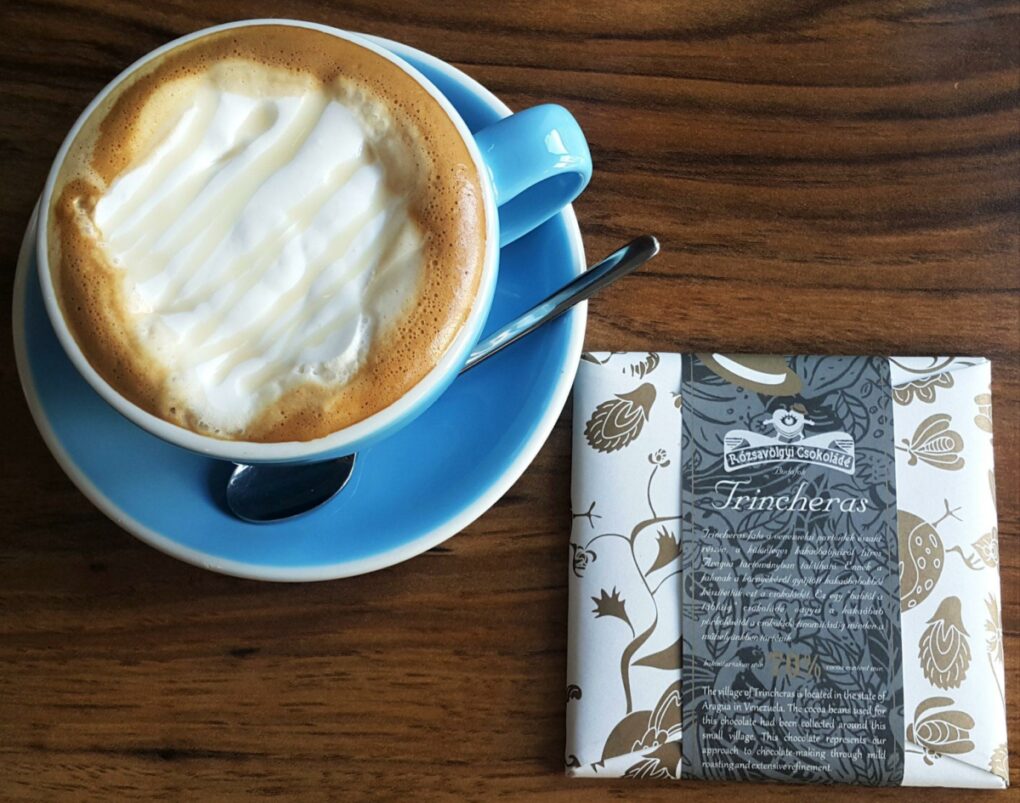
Generally speaking, most cups of tea contain more caffeine than chocolate, but will again depend on the type of chocolate and tea being compared. A single serving of dark chocolate provides caffeine levels in the middle range of a single cup of tea.
The milk chocolate caffeine level is a lot lower, comparable to the most decaffeinated white teas. However, consider that tea and coffee are low in calories and pretty widely self-regulated thanks to their stimulating effects.
This allows a person to consume as many as 4 or 5 cups a day. In comparison, the daily recommended consumption of chocolate is only 1 to 2 oz. Like chocolate, tea also contains theobromine, but not as much as is found in chocolate.
However, an amino acid called theanine is exclusively found in tea, and helps increase feelings of relaxation. It’s said to work by stimulating alpha brainwave activity, which is strongly associated with a meditative state.
Similar to chocolate, the polyphenols in tea slow down caffeine's absorption, blunting the sharp stimulation and crash associated with coffee.

Caffeine in Hot Chocolate
Like the other drinks mentioned previously, hot chocolate has a range of caffeine levels. However, the amount is small in most cases, because the only source of caffeine in hot cocoa is in the cacao itself. Hot cocoa, much like chocolate milk, is usually diluted with other ingredients and then mixed with milk to smooth the cocoa’s bitterness.
The range of caffeine in hot chocolate can range between 0 to 2 mg per 8-oz cup of ready-to-drink powdered hot chocolate, and between 12.5 mg to 16 mg of caffeine per 8-oz cup made using 2 tablespoons of cocoa powder.
Like normal chocolate, the higher the dark cocoa solids content, the more caffeine the drink will contain. Yet compared to decaffeinated coffee and tea, a cup of hot chocolate may seem to have slightly more caffeine.
However, the majority of tea and coffee beverages will have considerably more caffeine, with almost three to four times more in tea, and up to 6 times more in coffee. Since hot chocolate is usually mixed with milk, it contains other nutritional content such as calcium, potassium, phosphorus, iron, vitamin D, carbohydrates, fiber, protein, and sugar.
This also means that a cup of hot chocolate contains an average of 190 calories per 8 oz cup. For those looking to get more caffeine out of their morning cocoa, caffeinated hot chocolate products do exist, and they generally contain caffeine levels comparable to brewed coffee.

Chocolate Caffeine FAQ
The amount of caffeine in chocolate depends on factors such as the origin of the cocoa beans and the type of chocolate. Beans from South America can contain twice as much caffeine as other beans. Caffeine is found only in cocoa solids and not in cocoa butter, so a higher cocoa percentage will usually equate to more caffeine.
The most caffeine-rich dark chocolates, such as a bar of Ecuadorian 100% dark chocolate, can have caffeine content comparable to a shot of espresso. However, in most cases, chocolate contains considerably less caffeine than coffee.
Tea can have a wide range of caffeine levels. Like coffee, tea generally contains more caffeine than chocolate. A single 50g serving of dark chocolate has a caffeine level comparable to the middle levels of caffeine found in tea. However, milk chocolate will have considerably less caffeine than most white tea, and the number of recommended servings per day is also lower.
75% and above dark chocolate made of cocoa beans sourced from South America will have the most caffeine content. The presence of more cocoa solids equate to higher caffeine levels, and the South American nibs contain as much as twice the caffeine levels.
An 8 oz cup of decaf coffee contains between 2 to 15 mg of caffeine. Dark chocolate will have more caffeine, but milk chocolate (at only 7mg per serving), may or may not have more.

















Lalai
very informative article! answered all of my questions!?
Max
Thank you! I'm glad to hear that, Lalai.